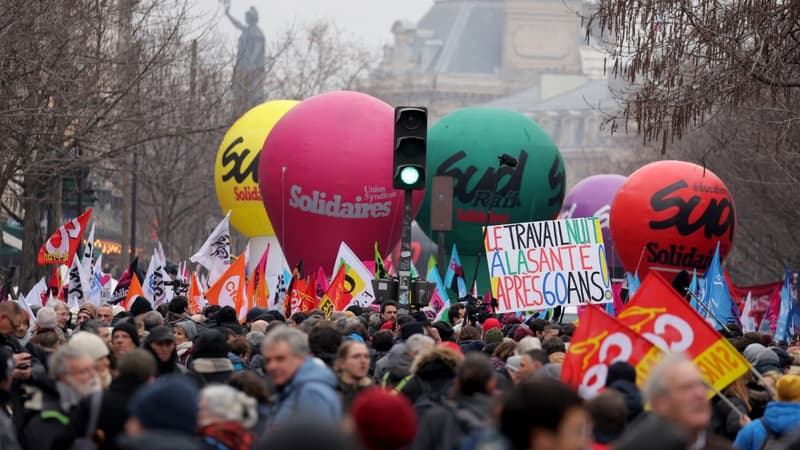Many observers doubted the mobilization capacity of union organizations in recent years. Announced with great fanfare by a united union front never seen since 2010, moments after the press conference to present the government’s pension reform project, the mobilization on Thursday, January 19, was all proof of the truth. And the unions seem to have achieved it, at least occasionally, by bringing together 1.12 million people according to the public authorities while demanding the crossing of the bar of the two million protesters on their side.
If we trust the figures of the public authorities, it is simply the third day of mobilization at the initiative of the unions that have gathered the most people in 30 years in France. On October 12, 2010, the demonstration against Eric Woerth’s pension reform had mobilized 1.23 million people while the one against the “Fillon” law had gathered 100,000 less on May 13, 2003. If we Focusing on the figures of the unions, yesterday’s mobilization is close to the level reached by that of December 12, 1995 when more than 2.2 million people marched against the Juppé plan. So does Thursday, January 19, mark the return of the unions? BFM Business gives you some answers.
From union delegates to personnel representatives
Before speculating on the long-term impact of this first day of mobilization against the pension reform, it is necessary to recall what the French trade union situation was like a few weeks ago and its recent trends. In short, the global trend for about half a century has been a decline in the presence of unions within the workforce. Several factors explain this phenomenon, such as the emergence of a service economy to the detriment of the secondary sector, social dialogue reforms or even advances in labor legislation with the Aubry laws on 35-hour work and RTT.
“These observations, of course, must be qualified: in large industrial establishments, for example, the unions are still present and are even undergoing forms of renewal of their militant workforce,” he adds.
Shop stewards are increasingly becoming employee representatives specializing in social dialogue. More recently, Macron’s 2017 ordinances helped concentrate union responsibilities while reducing the number of staff representatives. “This situation has contributed to weakening the daily links of these representatives with their colleagues, giving way to free mobilizations of the trade union framework, as recently in the SNCF”, underlines the political scientist from Rennes 2 University.
Increase in demonstrations to the detriment of strikes that benefit “competitors”
In addition to weakening, the union movement faces the rise of competition. This has benefited from the retreat of the strike for several decades, which is once again linked to the same socioeconomic factors, namely de-industrialization, the dissolution of work collectives or even the increase in precariousness. Thus, the recourse to strikes tends to be redirected towards an ever smaller nucleus of workers, in public services or in certain industrial sectors, while it is reduced to the indispensable minimum in large sections of the world of work, particularly in the service trades and in small and medium-sized enterprises”, says Pierre Rouxel.
Strikes are replaced by demonstrations as a form of protest, which leaves the door open to less formal and structural organizations than unions, that is, to movements such as the yellow vests typically.
A favorable social context, an available political lever
In the long term, the context seems quite unfavorable for the unions, but in the short term they seem to benefit from a return to the forefront of wage demands, such as the revaluation of the minimum wage or the improvement of working conditions and, in general, life “Since 2021, the rise in prices has been accompanied by an intensification of strikes for wage increases, particularly in sectors considered not very Protestant (retail trade, food, etc.)”, adds Pierre Rouxel.
Although the researcher believes that the unions would have every interest in including political forces in their mobilization from now on, the union organizations had opened the door to this convergence in view of the day of January 19. An invitation to which some left-wing personalities responded favorably, although young activists from left-wing parties supported by La France Insoumise preferred to organize their own demonstration this Saturday.
transform test
After the success of the mobilization on Thursday, the hardest part is yet to come for the unions, which will have to transform the trial. Basically, they take advantage of an issue that concerns all workers and against which a large number of them can unite, namely the extension of the legal retirement age. In this way, the unions must avoid acting in daily episodes of action to give weight to the protest in the hope of obtaining the withdrawal of the project presented by the government, but without the movement losing popularity among the French.
Several union representatives thus evoke the desire to carry out other large-scale operations such as the national secretary of the CFDT Yvan Ricordeau. “As long as there is a reform whose balance is based on the postponement of the age of majority, the unions are going to mobilize,” he explained on RTL this Friday morning. The same story with the general secretary of the CGT-Education Marie Buisson. “We want to go as far as the withdrawal of the reform,” the candidate for Philippe Martínez’s succession insisted on Franceinfo while he called for “massive and strong strikes.” The latter hopes that the next day of mobilization, scheduled for Tuesday, January 31, will attract at least as many people as the one on the 19th.
Before this day, detained at the behest of the CFDT while other unions preferred a shorter term, the organizations are calling for more action, especially around January 23, the day the law is presented to the Council of Ministers. The CGT’s confederal secretary, Catherine Perret, spoke Thursday of the demonstrations “in front of the prefectures” on Monday.
Source: BFM TV


